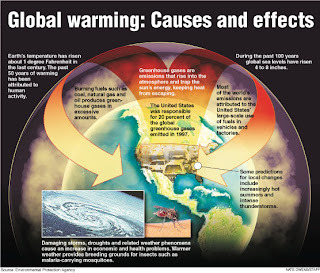
Tuesday, 28 August 2007
Friday, 24 August 2007
How We Can Help To Reduce Global Warming?
The three ways in which we can help to reduce global warming are:
- Use energy more wisely by adopting energy-efficient vehicles and appliances.
- Switch to renewable energy sources such as wind and sun.
- Leave forests to grow and plant trees in deforested areas.
Carbon Trading Arrives in India
When GoodNewsIndia interviewed Dr.U.Shrinivasa for the Bio-diesel story and he held forth on the coming market for Carbon Trading, it had seemed futuristic. But it has already arrived in India with Jindal Vijaynagar Steel declaring itself ready to sell $225 million worth of saved carbon over the next 10 years.
Well, what is Carbon Trading? Let’s rewind to the Kyoto Protocol of 1997 by which all countries are required to reduce their greenhouse gas emissions by 5% --from 1990 levels-- in the next ten years, ie 2012—or pay a price to those that do. The idea was to make developed countries pay for their wild ways with emissions while at the same time monetarily rewarding countries with good behaviour in this regard. Since developing countries can start with clean technologies, they will be rewarded by those stuck with ‘dirty’ ones. Say a company in India can prove it has prevented the emission of x-tonnes of carbon, it can sell this good carbon-karma to a company in say, the US which has a bad karma. An environment-fundamentalist may say it’s all a bit like an indulgent epicure paying someone else to diet for him, but then that’s another story. Right now, there is a market opportunity for India—but only till 2012. Closer to that clean-up date prices of carbon credits will rise and in the years leading up to it there will be a scramble to buy credits cheap. The World Bank has built itself a role in this market as a referee, broker and macro-manager of international fund flows. The scheme has been entitled Clean Development Mechanism [CDM] in 2000, or more commonly, Carbon Trading.
Jindal on Oct 19, said that the Corex furnace technology that it employs would prevent 15 million tonnes of carbon from being discharged into the atmosphere in the coming decade. At a sale price of $15/tonne that is a total of $225 million. Jindal says companies from the Netherlands, Canada, the US and Japan have begun talking to it. On Oct 22, the New Indian Express carried a story that said the World Bank had just handed over $10 million to India’s Infrastructure Development Finance Company to fund ‘clean’ projects that would generate saleable carbon credits. The carbon market is here. Dr. Srinivasa had imagined a role for rural India in this emerging market. He said that power generated by naturally grown fuels would yield carbon credits and revenue from their sale should be factored into, when evaluating a bio-diesel future. Will we do it before the carbon market closes? If we could, would not bio-diesel power be unbeatable economics?
What is Carbon Trading?
Emissions trading (or cap and trade) is an administrative approach used to control pollution by providing economic incentives for achieving reductions in the emissions of pollutants.
In such a plan, a central authority (usually a government agency) sets a limit or cap on the amount of a pollutant that can be emitted. Companies or other groups that emit the pollutant are given credits or allowances which represent the right to emit a specific amount. The total amount of credits cannot exceed the cap, limiting total emissions to that level. Companies that pollute beyond their allowances must buy credits from those who pollute less than their allowances or face heavy penalties. This transfer is referred to as a trade. In effect, the buyer is being fined for polluting, while the seller is being rewarded for having reduced emissions. Thus companies that can easily reduce emissions will do so and those for which it is harder will buy credits which reduces greenhouse gasses at the lowest possible cost to society.
There are currently several trading systems in place with the largest being the European Union's. The carbon market makes up the bulk of these and is growing in popularity. Many businesses have welcomed emissions trading as the best way to mitigate climate change. Enforcement of the caps is a problem, but unlike traditional regulation, emissions trading markets can be easier to enforce because the government overseeing the market does not need to regulate specific practices of each pollution source. However, monitoring (or estimating) and verifying of actual emissions is still required, which can be costly. Critics doubt whether these trading schemes can work as there may be too many credits given by the government, such as in the first phase of the European Union's scheme. Once a large surplus was discovered the price for credits bottomed out and effectively collapsed, with no noticeable reduction of emissions.
Subscribe to:
Comments (Atom)